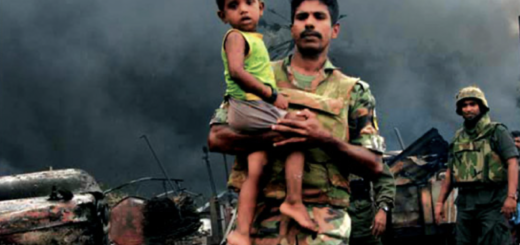Correcting 40 years of lies about Sri Lanka’s July 1983 riots – Tamils, please set the story straight
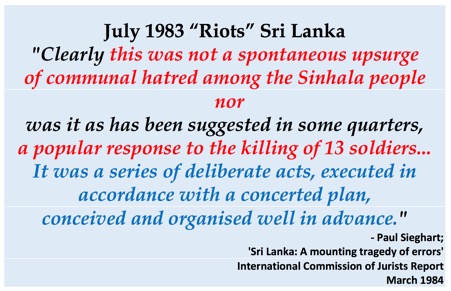
When countries with records of unprecedented mass murders feel it politically fashionable to annually commemorate an incident which took place in Sri Lanka which is miniscule to the crimes they committed, when political correctness has silenced people & prevented them voicing the truth, at least this 40th year we need to produce some unpalatable facts for all to digest in particular the countries with murderous records.
The background to 1983
- July 1975 Prabakaran committed his first assassination in killing Jaffna Mayor Alfred Duraiappah
- May 1976 Vaddukoddai Resolution calling for a separate Tamil state & calling upon youth to take up arms.
- 1977 – A pro-US government J R Jayawardena came into power. He was, openly anti-Indian (at a time India was tilted to Russia) To secure Sri Lanka’s territory from illegal Indian immigrants, N Q Dias, the foreign minister to Mrs. Sirimavo Bandaranaike, set up military camps in the North. Why or on whose advise is unknown by these camps were removed by President JR after coming to power.
- The Jain Commission Report following assassination of former Indian PM Rajiv Gandhi confirms that India began training Sri Lankan Tamil youth as armed militants, the camps where training was given was mentioned as well. These took place from mid 1970s. Affidavits presented further provided evidence of India helping armed militancy..
- Ironically, the father of Tamil separatism S J V Chelvanayagam passed away in April 1977 a month after declaring “My advice to the Sinhalese leaders is to allow us to go our way ..” (26 March 1977). His son-in-law A J Wilson was JRJ’s constitutional advisor.
- 1981 UNP accepts blame for the burning of the Jaffna library.
- 1982 JR Jayawardena instead of holding elections in 1983, decides to hold a referendum in 1982 & extended his term by another 6 years making a mockery of democracy.
https://www.shenaliwaduge.com/chronology-of-tamils-taking-firearms-since-1950s/ A perusal of this list will show you that by 1983 at least 56 recorded incidents of Tamils using arms have been recorded
- Shooting Sinhalese – 1956,
- Attacks on Army camps – 1956, 1961
- Assassination of politicians – 1970 (attempted Deputy MP Chandrasiri) 1971 failed assassination attempt on Duraiappah succeeded in 1975, UNP leader R Balasundaram killed in Kilinochchi.
- Making explosives – 1971, 1973
- Bombs thrown at police – 1974 (visit to Jaffna by PM)
- Shooting Police – armed youths begin attacks on Tamil police, 14 policemen killed in 1978 including Bastiampillai, 3 policemen in 1979, 2 policemen in 1981 (altogether 19 policemen had been killed from 1978-1981)
- Arson & violence – 1975 (Thangathurai group, Tamil New Tigers)
- Bank robberies – 1974, 1975 (Peoples Bank by LTTE), 1977, 1978. 1981
- Bombing of plane – 1978 AVRO 748 Air Ceylon blasted.
- In 1977 – 10% of Jaffna population were Sinhalese (bakers, traders, civil servants & businessmen)
- The Aug-Sept 1977 riots is also noteworthy & the Sansoni Commission report will reveal much & negate the oft promoted narrative only against the Sinhalese. This commission report is critical to understand the bigger picture.
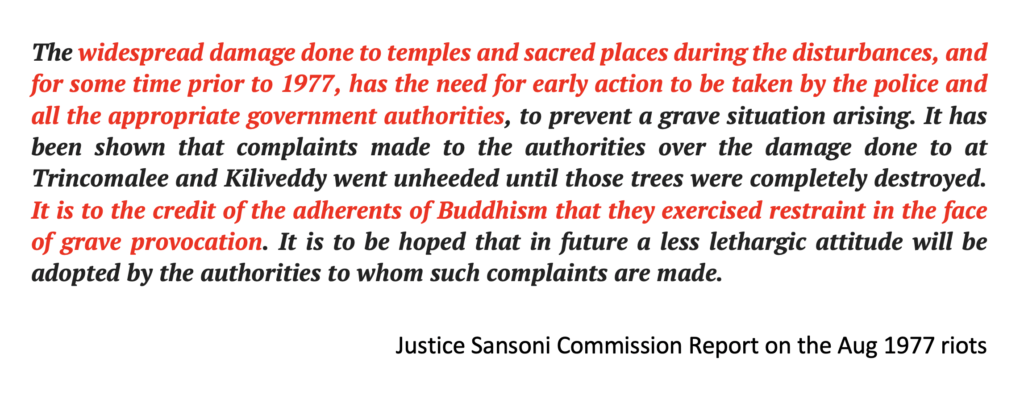
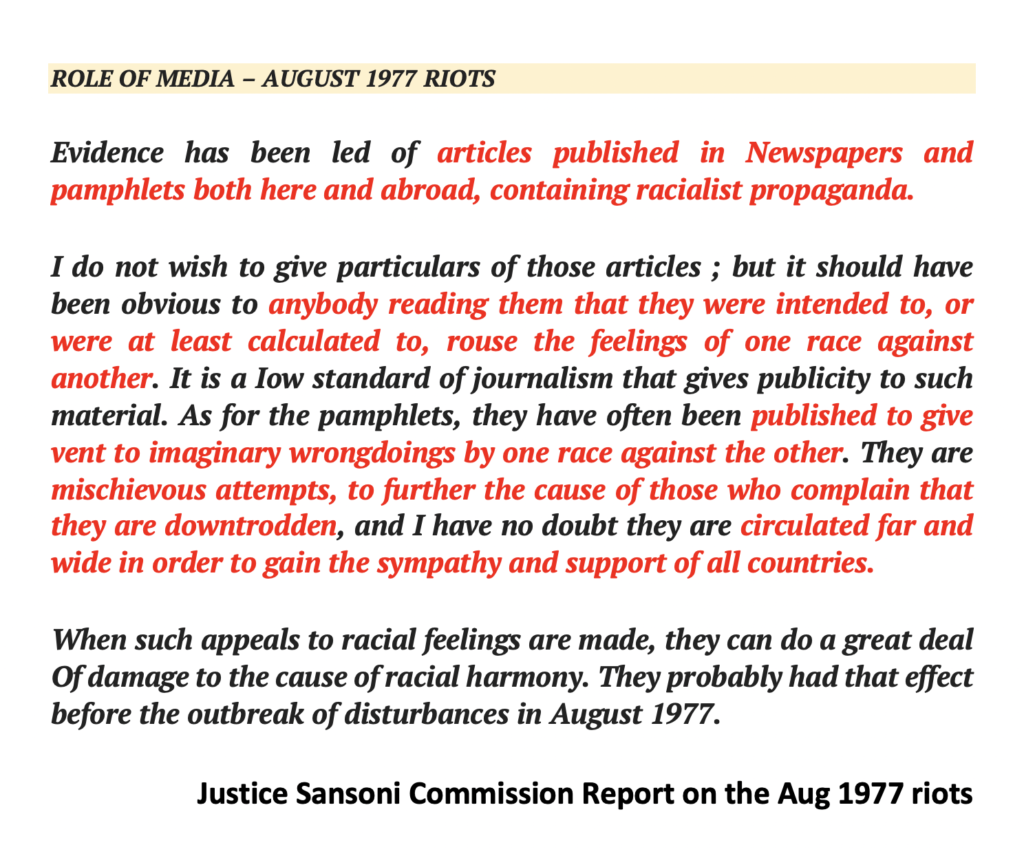
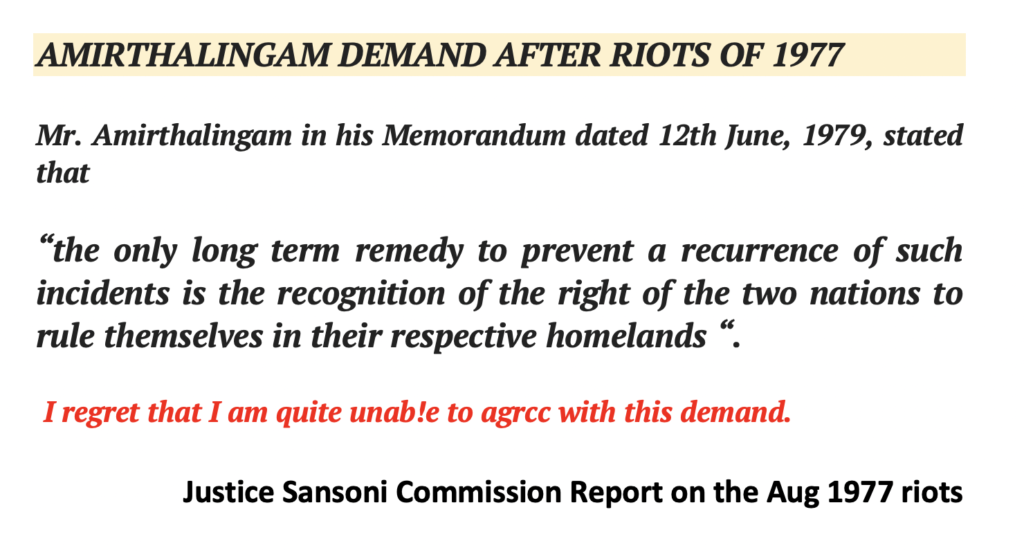
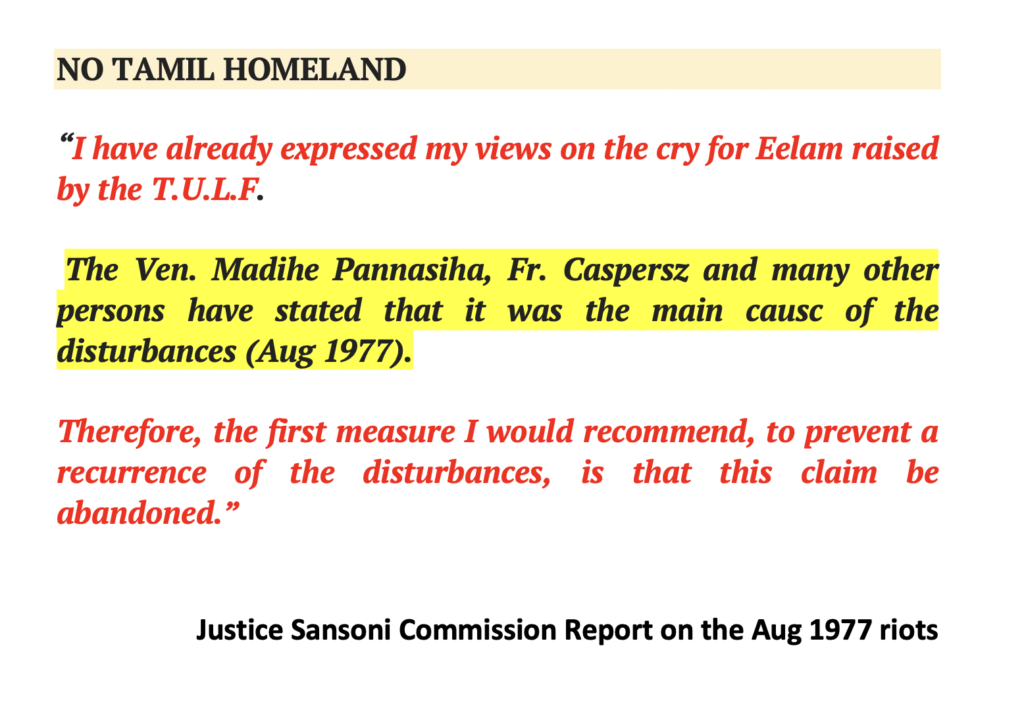
- LTTE was proscribed in 1978.
What is clear is that by 1980s – India was training Sri Lankan Tamil youth in guerilla warfare, Tamil Nadu became a logistics hub and numerous killings were taking place in the North by these groups including bank robberies and India-trained Tamil militants had killed 19 Sri Lankan policemen by 1981. 19 policemen is 5 more than the 13 Sri Lankan soldiers killed on 21 July 1983 which is falsely used as a reason for the July 1983 riots as Paul Sieghart of International Commission of Jurists concluded.
The Foreign Newspapers on 1983
- London Times on 8 Aug 1983 admitted that the rioters had a “particularly detailed knowledge of who lived where & who owned what” – this clearly shows it was NOT a spontaneous riot. It was planned.
Foreign Reports on 1983
- Paul Sieghart of the International Commission of Jurists in March 1984 too admitted it was “not a spontaneous upsurge of communal hatred among the Sinhala people” and the most important part comes in his claim that it was also not a “popular response to the killing of 13 soldiers”. He concludes that it was a “series of deliberate acts, executed in accordance with a concerted plan,conceived and organized well in advance”. Crucial points – it was not communal hatred by Sinhalese nor revenge for killing of 13 soldiers but a series of deliberate acts with a concerted plan & organized well in advance.
So the natural question should be WHO devised the plan & WHY & WHAT was the end objective. So far no one has bothered to answer this.
A riot did take place – if it was spontaneous it should have occurred immediately after becoming aware of the deaths of 13 soldiers on 23 July 1983. Not many know that between 1981-1983 nearly 35 soldiers had been killed. The riots began only on 25 July 1983 by a gang from Wanathamulla (that should give a further clue)
How did the rioters know which homes were Tamil – they were given electoral lists by UNP MPs to their supporters. These supporters were from all ethnic groups, united by political affiliation & united in their common goal to loot. There were no SLFP, or other political party supporters involved in the riots. JVP however were blamed & banned. That UNP organized the riots was clear because their Tamil friends & Tamil shops were protected & guarded. Nothing happened to Sea Street the home of the Tamil jewelers.
Anyone who joined the riots, joined not because they were Sinhalese, Tamils or Muslims but because they saw the window of opportunity to loot & plunder. There was no ethnic element to the looting.
Incidentally, the IGP at the time was a Tamil & the 6 next in line senior officers were also Tamils. After a whole day of watching rioting, curfew was imposed & media was gagged. The official dead figure was 350 out of which 50 were Sinhalese. No one seems to be mourning them.
The International Commission of Jurists report also claims some homes/businesses of Tamils were self-inflicted (to facilitate application for refugee or collect insurance), some Tamils claimed themselves victims to get passage overseas.
The Sinhalese have been made to feel guilty, primarily because they have failed to explore the circumstances that led to the incident in 1983, read & appraised themselves of the background incidents leading to 1983 & have been happy to run with the popular politicized bogus narrative. When rioters/looters have voters lists, when UNP guard & protect their elite Tamil friends & businesses – where is the spontaneity of an attack?
Ultimately, close to 1million Tamils were able to live in Western climes, LTTE set up shop & a kitty with an annual profit of $350m & Sinhalese got the blame for an incident they did not commit.
It is against this injustice of branding the 1983 riots as a riot by the Sinhalese against the Tamils is what we are trying to clear even after 40 years. The injustice continues because countries who have blood on their hands, are happy to be commemorating & issuing statements shedding crocodile tears for an event that is wrongfully playing a guilt trip on the Sinhalese, when the crimes by these countries are yet to be accounted for.
Most Tamils who were saved by their Sinhalese friends have not forgotten that ugly day in 1983, but there is no outward proclamation to silence the false propaganda & for 40 years, the world has been made to falsely believe Sinhalese attacked Tamils in July 1983.
Sinhalese do not expect thanks after 40 years, but it would be nice if the Tamils finally admitted that the attacks that took place in July 1983 were a political riot by a political party with their party supporters who comprised looters of all ethnicities.
This 40th year – this is all that the Sinhalese are asking of the Tamils. Please set the story straight.
Shenali D Waduge

